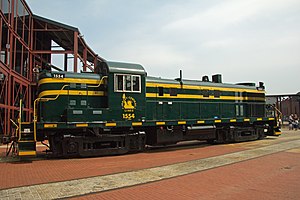ALCO RS-3
This article includes a list of general references, but it lacks sufficient corresponding inline citations. (June 2017) |
| ALCO RS-3 | |||||||||||||||||||||||||||||||||||||||
|---|---|---|---|---|---|---|---|---|---|---|---|---|---|---|---|---|---|---|---|---|---|---|---|---|---|---|---|---|---|---|---|---|---|---|---|---|---|---|---|
 A former Central Railroad of New Jersey ALCO RS-3 at Steamtown National Historic Site | |||||||||||||||||||||||||||||||||||||||
| |||||||||||||||||||||||||||||||||||||||
| |||||||||||||||||||||||||||||||||||||||
| |||||||||||||||||||||||||||||||||||||||
| |||||||||||||||||||||||||||||||||||||||
The ALCO RS-3 is a 1,600 hp (1.2 MW), B-B road switcher diesel-electric locomotive. It was manufactured by American Locomotive Company (ALCO) and Montreal Locomotive Works (MLW) from May 1950 to August 1956, and 1,418 were produced — 1,265 for American railroads, 98 for Canadian railroads, 48 for Brazilian and 7 for Mexican railroads. It has a single, 12 cylinder, model 244 engine.
Competition
ALCO built the RS-3 to compete with EMD, Fairbanks-Morse, and Baldwin Locomotive Works. In 1949, EMD introduced the EMD GP7. In 1950, Fairbanks-Morse introduced the 1,600 hp (1.2 MW) H-16-44. Also in 1950, Baldwin introduced the 1,600 hp (1.2 MW) Baldwin AS-16. In the case of ALCO, Fairbanks-Morse, and Baldwin, each company increased the power of an existing locomotive line from 1,500 to 1,600 hp (1.1 to 1.2 MW), and added more improvements to create new locomotive lines. All of this was to be more competitive with EMD. ALCO's 1,500 hp (1.1 MW) line was the RS-2, although 31 were built in 1950 with 1,600 hp (1.2 MW). Fairbanks-Morse's 1,500 hp (1.1 MW) line was the H-15-44. Baldwin's 1,500 hp (1.1 MW) line was the Baldwin DRS-4-4-1500. EMD, however, kept its competing GP7 at 1,500 hp (1.1 MW). But in 1954, EMD introduced the GP9. It was rated at 1,750 hp (1.30 MW).
In the end, EMD won the road switcher production race. EMD produced 2,729 GP7s. ALCO produced 377 RS-2s, and 1,418 RS-3s. Fairbanks-Morse produced 30 H-15-44s, and 296 H-16-44s. Baldwin produced 32 DRS-4-4-15s, and 127 AS-16s.
Brazil
In 1952 the Brazilian railway the Estrada de Ferro Central do Brasil purchased forty six new RS-3s from the Montreal Locomotive Works. Some are still active as work train engines for CPTM, Supervia, and CBTU – BH respectively São Paulo's, Rio de Janeiro's and Belo Horizonte's commuter railways. In Brazil these units were nicknamed Canadians or Hot Tails.
Spain
In 1964 the Spanish railway the Ferrocarril de Langreo purchased four RS-3s from the Terminal Railroad Association of St. Louis. A fifth unit, number 1604, was purchased in 1971 from the Burlington Northern Railroad (BN), a piece of surplus Great Northern Railway stock from the 1970 merger that formed BN. The locomotives served until 1984, when the line was converted to 1,000 mm (3 ft 3+3⁄8 in) metre gauge.[1]
See also
- RS3m, a rebuild of the RS-3
- List of ALCO diesel locomotives
- List of MLW diesel locomotives
References
- Dorin, Patrick C. (1972). Chicago and North Western Power. Burbank, California: Superior Publishing. p. 140. ISBN 0-87564-715-4.
- Pinkepank, Jerry A. (1973). The Second Diesel Spotter's Guide. Kalmbach Publishing Co., Milwaukee, WI. pp. 243–244. ISBN 0-89024-026-4.
- Solomon, Brian (2000). The American diesel locomotive. MCI Publishing Company. ISBN 0-7603-0666-4.
- Coelho, Eduardo J. J.; Setti, João B. (1993). A era diesel na EFCB. Associação dos Engenheiros Ferroviários.
- ^ "Ferrocarril de Langreo en Asturias". AlcoWorld. 2000-05-14. Retrieved 2007-09-13.
- ALCO locomotives
- B-B locomotives
- MLW locomotives
- Railway locomotives introduced in 1950
- Passenger locomotives
- Freight locomotives
- Standard gauge locomotives of the United States
- Diesel-electric locomotives of Brazil
- Standard gauge locomotives of Spain
- 5 ft 3 in gauge locomotives
- Standard gauge locomotives of Canada
- Diesel-electric locomotives of Canada
- Diesel-electric locomotives of Spain
- Diesel-electric locomotives of the United States
- Diesel locomotive stubs
